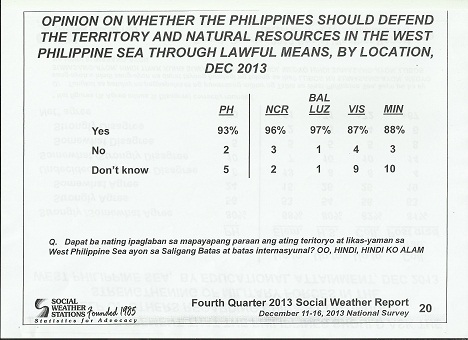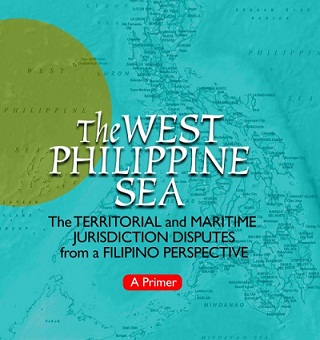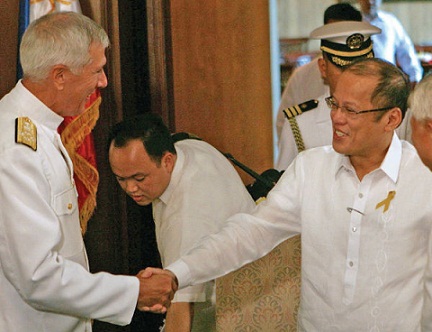Does Foreign Secretary Albert del Rosario have a problem with the case filed with the United Nations Arbitral Court against China’s nine-dash line map that prompted him to commission Social Weather Stations to do a survey which focused on the case and the problem with China in the West Philippine Sea?
SWS conducted a nationwide survey among 1,550 respondents on Dec. 11 through 16.
Foreign Affairs Spokesman Raul Hernandez said they wanted to know the sentiments of the public on specific issues and the results showed that the Filipino people “overwhelmingly” support the case filed by the Philippines at the UN Arbitral Tribunal January last year.
The results could not be less than “overwhelming” what with questions like “Dahil ang Tsina ay malakas sa aspetong military at ekonomiya, sinampahan natin ng kaso ang Tsina sa United nation sa paniniwalang pantay-pantay ang labanan sa ilalim ng batas internasyunal. Sang-ayon ba kayo o hindi?” (Opinion on whether the international law is a great equalizer against countries that are stronger militarily and economically.) Answer: 77% Yes; 15 % No; 8% Don’t know.

Overwhelming approval
Another question: “Dapat ba nating ipaglaban sa mapayapang paraan ang ating teritoryo at likas-yaman sa West Philippine Sea ayon sa saligang Batas at batas internasyunal?(Opinion whether the Philippines should defend the territory and natural resources in the West Philippine Sea through lawful means.) Answers: 93 % Yes; 2% No; 5% Don’t know.
It’s like asking someone, “Do you like your life to be good?” Or a wife asking a husband, “Would you grieve if I die?”
A reporter asked Hernandez and SWS President Mahar Mangahas why they didn’t ask respondents whether they agree to the proposal of China to talk about the territorial conflict in the West Philippine Sea bilaterally. They did not explain why that question was not included.
It would have been interesting if the respondents were asked,“If China continues to occupy other islands being claimed by the Philippines in the West Philippine Sea, would you support the use of force by the Philippine government? Would you volunteer to join the Philippine contingent?”
Mangahas said they were the ones who formulated the questions based on the objective laid out by the DFA. The questioned were approved by the DFA.
The respondents were also asked, ““Tungkol sa patuloy na pagpapalakas ng puwersang military ng Tsina sa West Philippine Sea, kayo po ba ay sang-ayon o hindi-sangayon na dapat tayong humingi ng tulong sa iba?” (Degree of Agreement that the Philippines should ask the help of others regarding China’s continuous strengthening of military forces in the West Philippine Sea?)
Answers:Strongly/Somewhat Agree (80%); Undecided If Agree or DisAgree (8%); Somewhat/Strongly Disagree (10%).
It would have been interesting to know if the respondents believe other countries will help the Philippines in case there would be armed confrontation between the Philippines and China.
Mangahas shared a survey result, not commissioned by the DFA, showing that trust in China is minus 17 as against plus 82 in the US, plus 53 in Australia, plus 47 in Japan, plus 11 in Taiwan and plus 8 in Malayisa.
Mangahas said trust in China has been negative since 2012. Last year it was minus 30, he said.
I would be interested to know the answer to the question: “Do you approve cutting diplomatic relations with China?”
I think the survey results would be included in the memorial, documents to persuade the court to rule in favor of the filer’s position, which the Philippines is set to file not later than March 30, 2014. After that, the UN Arbitral Tribunal will decide whether it has jurisdiction on the case or not.
If the UN Arbitral Tribunal says it has jurisdiction, the proceedings will continue despite the non-participation of China. If the court says otherwise, it would be a major setback for the Philippines, especially for Del Rosario, under whose watch in the DFA relations with China deteriorated.
Since China knows that no pressure would make the Philippines withdraw the UN case,it has been lobbying with other Asean countries to pressure the Philippines to delay the filing of the memorial.
The 10-member Asean,as a group, has not made a position in support of the Philippines. Individually,only Vietnam, one of the claimants in the South China Sea islands, has expressed support in the Philippine case against China but it has declined Philippine request to intervene in the case.
The United States lauded the Philippines for bringing the issue to the UN court but stressed that it is taking a neutral position on the South China Sea territorial dispute.



